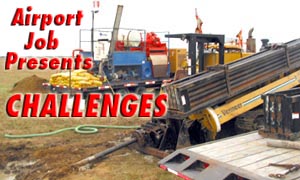
With planes taking off and landing overhead, the crew of Henniker Directional Drilling recently laid 2,500 feet of 4-inch galvanized steel pipe 10 feet under the Nantucket Airport runway in Massachusetts. Excavation wasn't an option, as the pipe needed to travel under a busy section of the runway that is constantly impacted by landing planes. The bore was completed in two clean shots, with no disruption of the runway surface and few disruptions to the airport's take-off and landing schedule.
The project included a 500-foot bore and a 400-foot bore of four pipes each. One set of two pipes was laid for existing communication lines, and the other two pipes were set for future expansion.

Logistics were another matter entirely. Getting to Nantucket requires a ferry ride, and crew members found themselves and their equipment bumped from several ferries. Once on site, moving didn't get any easier. Adding to the usual safety precautions, the airport was undergoing safety inspections that week. An FAA inspector monitored the crew's every move.
“The biggest challenge was being restricted in our movements,” Martin says, adding that the job could have easily been completed in one week instead of two without the restrictions. “Every move required clearance - even walking to the other side of the bore. The runway had to be shut down just for one of the guys to get a shovel, so there was a lot of waiting. To overcome this, we had to plan the next move to see how we could combine moves.”

So what's it like to work on an open runway? The unflappable Martin says, “It was a little unnerving, but we learned to look left and right. The planes were small - not like at Manchester Airport in New Hampshire, where we were right under huge jets, hearing the engines roar. Because there wasn't as much noise, we could better focus on the job at hand. Of course, we kept an eye to the sky.”

“This kind of success should build confidence in people who are considering directional drilling as an option,” Martin continues. “Not only is it a viable option, it's the only practical option for projects like this. The way we see it, if all this steel pipe was installed in one bore with no surface disruption, just imagine what directional drilling can do for an everyday utility installation project.”
ND
Report Abusive Comment